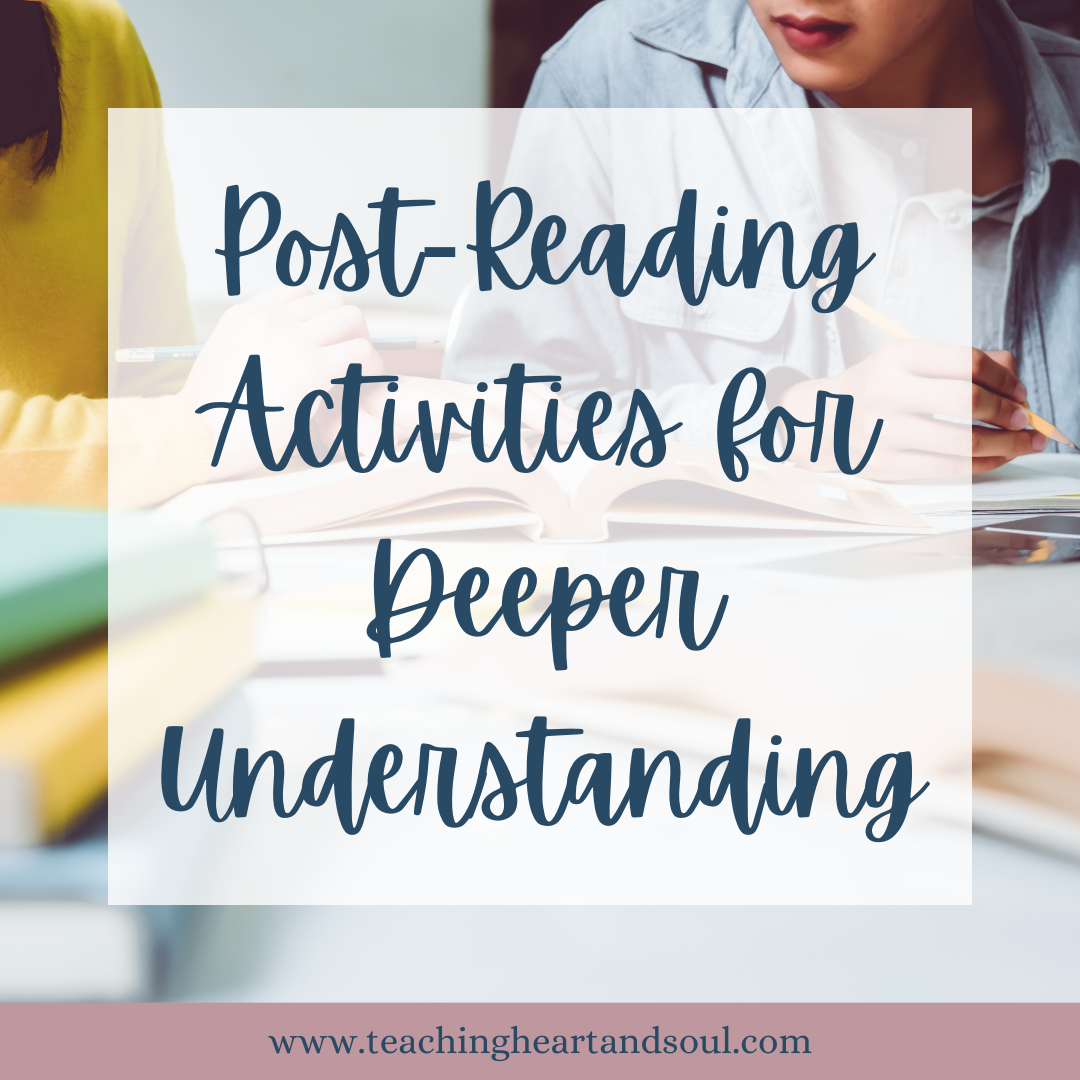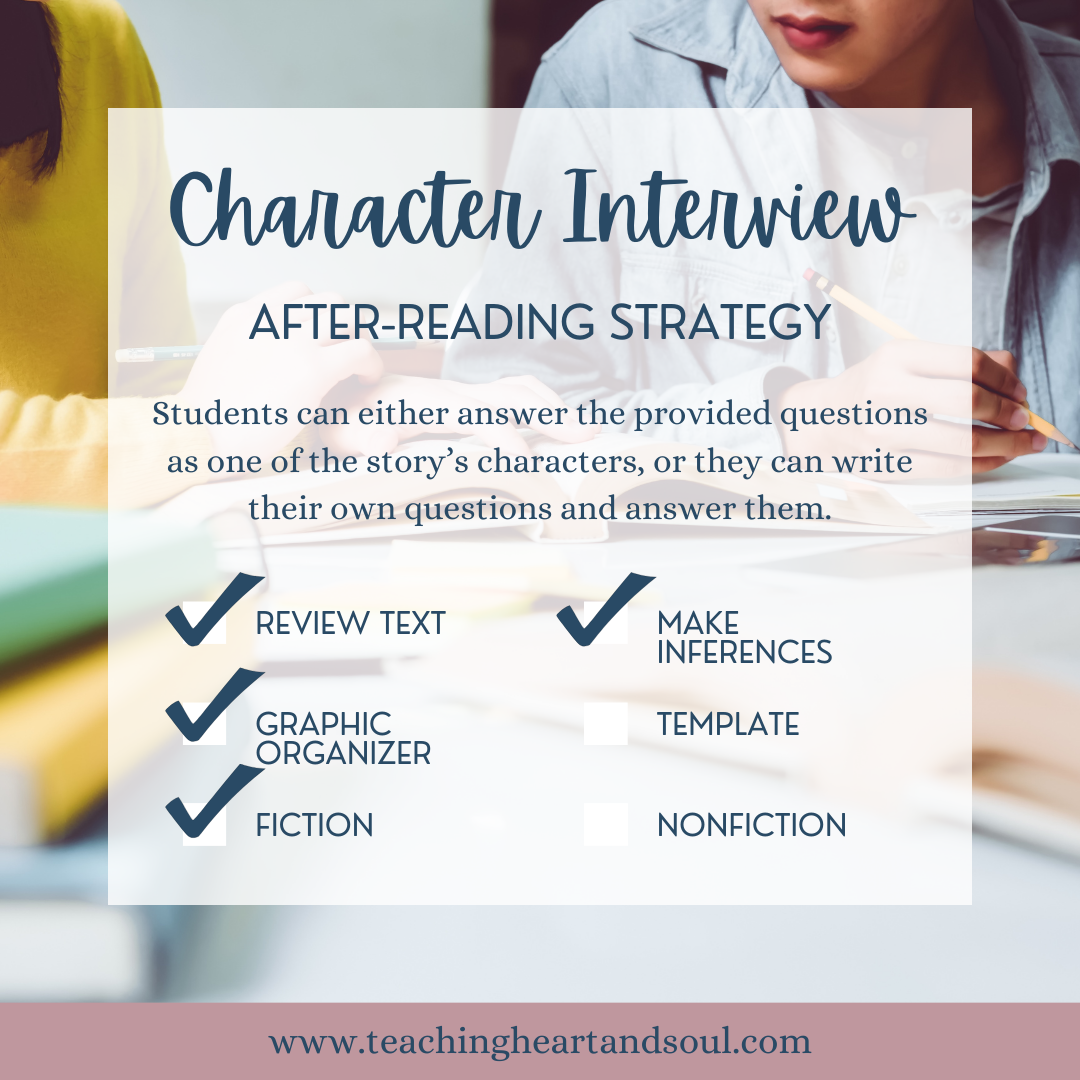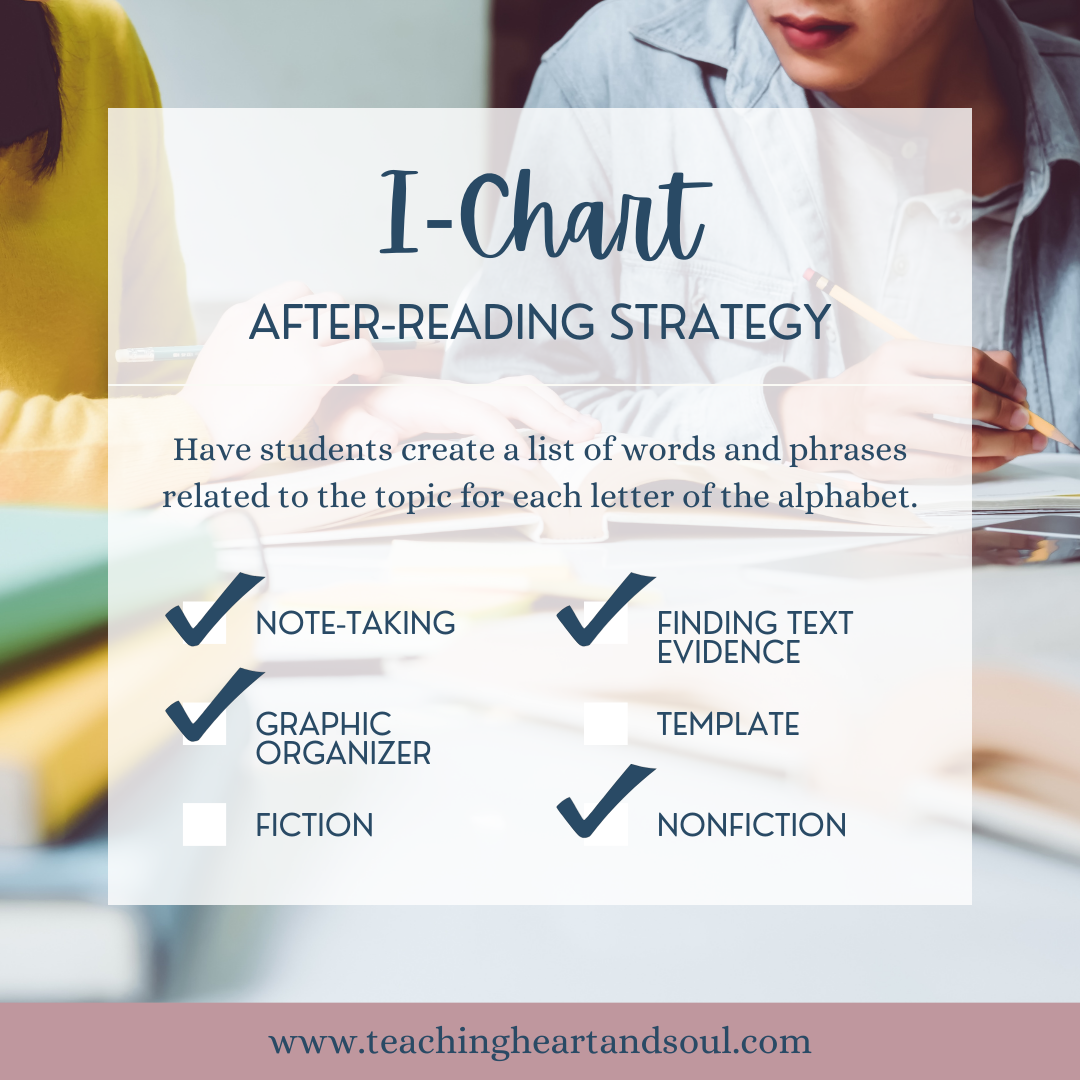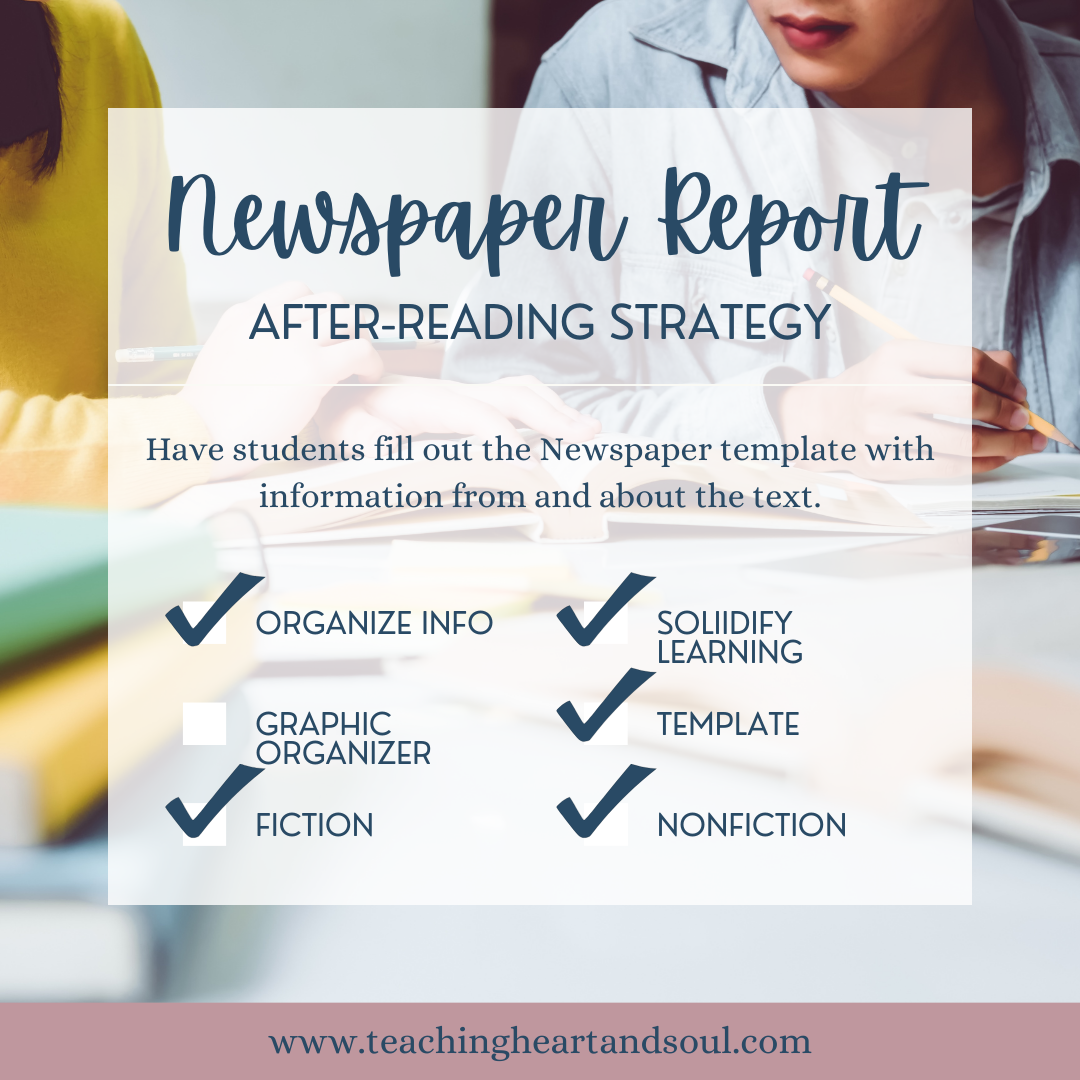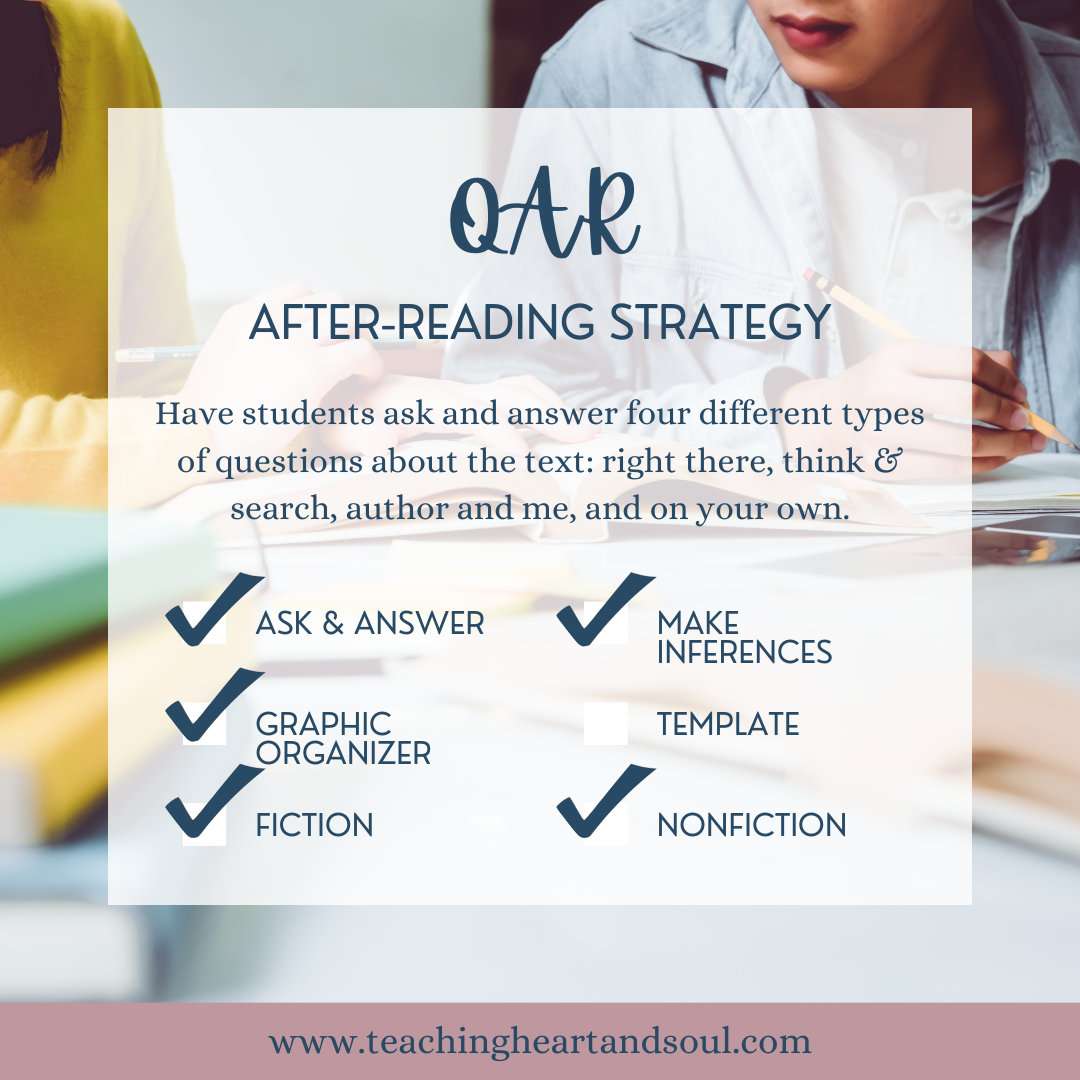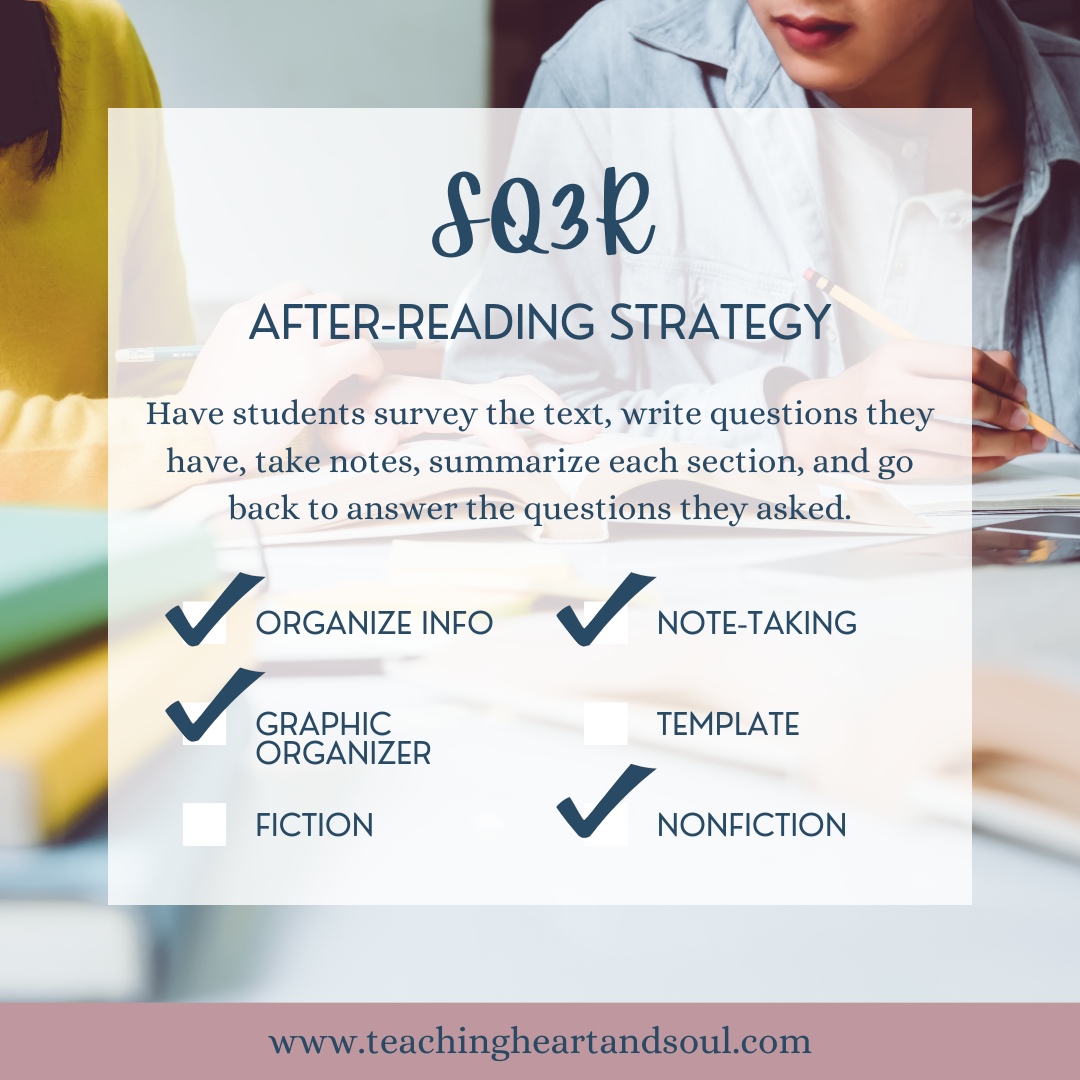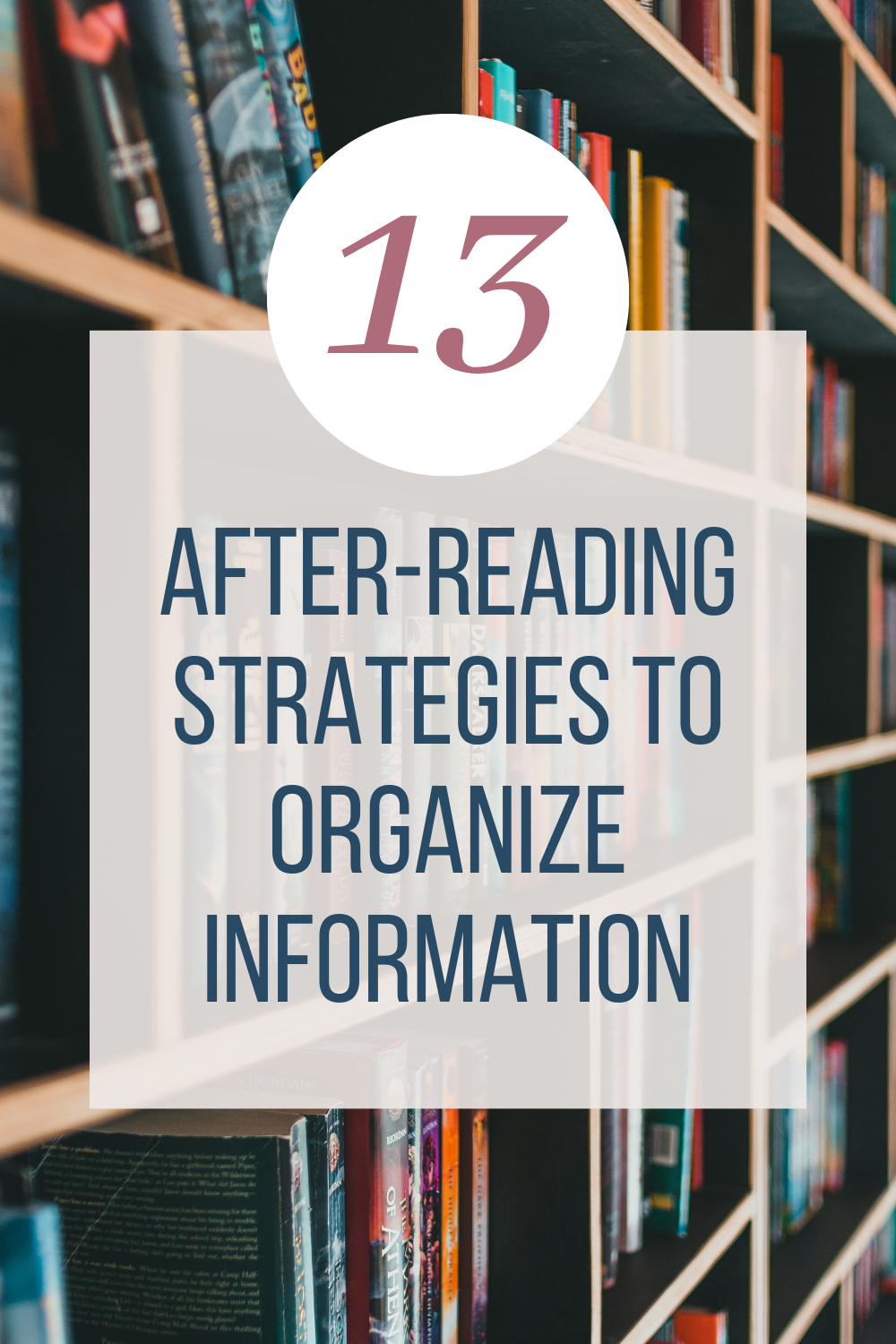Post Reading Activities for Deeper Understanding
Post reading activities facilitate a deeper understanding of a text and increase reading comprehension.
Once students have engaged with a text and absorbed its content, after-reading activities provide valuable opportunities for reflection, analysis, and application. By encouraging students to delve deeper into the material they've just read, after-reading activities foster a more comprehensive understanding of the text.
Oftentimes, these activities are more engaging than quiz questions and are easier to prepare than having to write questions, especially comprehension questions that are appropriately challenging for each novel or text.
In this context, we will explore several compelling reasons why after-reading activities are essential for students and how they contribute to the development of their reading comprehension skills.
Let’s cut to the chase. If you’re here for the corresponding worksheets, click HERE.
Solidify Learning
The first benefit of post-reading activities is that it allows students to review what they learned and solidify their knew knowledge or reading comprehension skill.
Organize Information
Another reason after-reading activities help with reading comprehension is because they give students opportunities to organize the information they learned.
Review
Completing these post reading activities is a great opportunity for review as well! Your young readers will retain information more easily when they have a change to organize that information using one of these strategies and can go over the information one more time.
Note-Taking
Your young learners will benefit from learning how to take notes. Many of these post reading activities give students opportunities to take notes in graphic organizers or by another method. Post-reading, readers can use their notes to organize the information they learned.
Engagement
When students have a purpose while reading, it is easier for them to stay engaged because they know what they should be paying attention to.
Introduce these post-reading activities to your young readers before you begin reading the text so that they are actively learning and pay attention. When you give them a task and a purpose, it will encourage them to truly pay attention.
After-Reading Activities
Below are post-reading activities you can do to motivate students in your classroom to engage in and understand their reading. Many of these activities could be done independently, as a whole group, or in two or three groups that are smaller.
Click HERE for worksheets to go along with these strategies. You can also click HERE for the bundle with pre-reading and during-reading strategies.
Alternate Ending
Writing an alternate ending to a story helps students remember what happened in the story. It also helps students better understand characters.
Implementation:
Review: First, review the basic plot of the story. Consider going through the exposition, rising action, climax, falling action, and resolution as a class.
Brainstorm: Next, have students take a moment to brainstorm ideas for an alternate ending. They’ll need to think through a moment in the story that they want to change that leads to a different outcome.
Write: Finally, have students write out their alternate ending.
Book Review
A book review activity encourages students to reflect on and analyze a book they've read, enabling them to articulate their thoughts and opinions about the text. Writing a book review not only helps students recall the key elements of the story but also encourages them to form a more in-depth understanding of the book's themes, characters, and overall impact.
Implementation:
Choose a Book: Select a book that is appropriate for the students' reading level and curriculum objectives. Ensure that the book has sufficient depth and complexity to facilitate a meaningful review.
Introduce the Activity: Explain to students that they will be writing a book review to share their thoughts and insights about the book they've read. Emphasize that this exercise will help them develop critical thinking and communication skills.
Review Elements: Discuss the essential elements that should be included in their book reviews. These elements may include:
Book Title and Author: Begin with the basic details of the book.
Summary: Provide a concise summary of the plot, avoiding spoilers.
Character Analysis: Analyze the main characters, their development, motivations, and significance to the story.
Theme Exploration: Identify and discuss the central themes or messages conveyed by the book.
Personal Opinion: Share their personal thoughts and opinions about the book, explaining what they liked or didn't like and why.
Recommendation: State whether they would recommend the book to others and provide reasons for their recommendation.
Favorite Quotes: Include notable quotes from the book and explain why they are meaningful or impactful.
Comparison: Compare the book to other works they've read or to real-life experiences if applicable.
Writing Process: Guide students through the writing process, encouraging them to organize their thoughts logically and coherently. Stress the importance of providing evidence or examples to support their opinions.
Presentation: Allow students to share their book reviews with the class through oral presentations or written submissions. This provides an opportunity for them to express their opinions and engage in discussions.
Character Interviews
Character interviews help students increase their reading comprehension by asking them to imagine themselves in a conversation with a character from the story. It promotes critical thinking, empathy, and a deeper understanding of character motivations, which are essential for comprehensive reading comprehension.
Implementation:
Select a Character: Choose a character from the text that you'd like students to interview. Ensure that the character is significant to the story and has a distinctive personality, beliefs, and motivations.
Introduce the Activity: Explain the purpose of the character interview to the students. Emphasize that it is a creative exercise to gain a deeper understanding of the character's thoughts, feelings, and actions.
Create Interview Questions: Have students create a list of interview questions they would ask the character if they were to meet them. These questions should focus on the character's experiences, motivations, and emotions. Encourage students to think critically about what they want to know.
Some examples might include:
“Describe a significant moment in the story from your perspective.”
“Describe your relationship with another character. How well do you get along? Why?”
“What event from the story helped shape who you are? How did it do that?”
“What was your biggest motivation? Why did you do what you did?”
“What was the most difficult choice you had to make (in the story)? What made that decision difficult? How did you make your decision?”
“What was your biggest challenge or obstacle?”
“What was your biggest fear throughout this journey?”
“How did you feel when all seemed hopeless? Why?”
“How did you feel when everything turned out in the end? Why?”
“How did you change over the course of the story? What caused that change?”
Conduct the Interview: In pairs or individually, students sit with each other and take on the role of an interviewer and the character. They can write down responses as if they were the character, considering how the character would answer based on the information provided in the text.
Share and Discuss: After completing the interviews, have students share their questions and responses with the class. Engage in a discussion about the different perspectives and insights gained through this creative exercise.
Comparative Analysis: Encourage students to compare their interview responses to the character's actions and dialogue in the text. Discuss any discrepancies or surprises in the character's responses and how these contribute to a deeper understanding of the character's complexities.
Reflect on Character Development: Ask students to reflect on how the character interview helped them comprehend the character's growth and development throughout the story. Discuss any changes or revelations in their understanding.
Written Reflections: Have students write reflections on their character interview experience. Ask them to explain how it improved their understanding of the character and the overall story. Encourage them to consider how this activity could be applied to other texts they read.
Conduct character interviews, where students assume the role of a character from the text and answer questions as if they were that character.
Need help implementing these strategies? Check out THESE worksheets.
Character Diary Entry
Writing a diary entry as one of the characters from the story helps students better understand the character and make inferences about the character’s feelings and motivations.
Implementation:
After reading a fiction story, have students write a diary entry as the main character or another significant character. Students should write (as the character) about a significant event from the story. Using inferences about the book, students should concentrate on the feelings, values, and motivations of the character.
Comic Rewrite
A comic rewrite is a more creative and artistic way to summarize a story. This strategy will help students learn to pull out the most important parts of a text. A comic rewrite promotes critical thinking, analytical skills, and the ability to determine which details and events are the most important to the story.
Implementation:
Summarize: After reading the text, have students summarize the plot (exposition, rising action, climax, falling action, resolution).
Illustration Notes: Have students plan out their comic by taking notes on each section and what illustrations they would like to include.
Comic: Finally, have students take their summary and notes to create a comic that summarizes the story. Encourage students to include word bubbles, thought bubbles, narrator text, visual sound effects, and action lines.
Exit Tickets
Exit slips help students solidify the information they learned before moving onto the next task.
There are many different types of exit tickets available, but they all help students boil the lesson down to the key points or idea.
Here are some ideas for exit slips to consider:
Main Idea
Key Points
One-Sentence Summary
One-Minute Exit Ticket
Brain Dump
The Muddiest Point
3-2-1 Exit Ticket
Then vs. Now
Teacher’s Shoes
Application
Read about these exit tickets in more detail HERE.
Check out my FREE exit tickets to increase active learning HERE.
The I-Chart Procedure
The I-Chart Procedure helps students practice note-taking and research skills.
Implementation:
Planning Phase:
Choose a topic of study.
Formulate questions to be answered through reading.
Use the chart to record information.
Collect materials related to the chosen topic.
Interacting Phase:
Record prior knowledge about the topic.
Record any additional information acquired from reading.
Discuss and record pertinent questions.
Read and discuss sources with teacher guidance.
Integrating and Evaluating Phase:
Create a summary for each question on your chart using the information you collected.
Compare your summaries with your existing background knowledge and make clarifications as needed.
Discuss your new knowledge.
Locate and incorporate new information that addresses unanswered questions.
Present your findings and insights to the group.
Use the graphic organizer included HERE to facilitate this activity.
Infographic
The infographic activity is a dynamic after-reading strategy that empowers students to condense and visualize key information from a text into a concise and visually engaging format. This strategy not only enhances reading comprehension but also sharpens their skills in data presentation, critical analysis, and graphic design.
Implementation:
Introduce the Concept: Explain to students that they will be creating infographics to summarize and convey essential information from the text they've read. Highlight the value of using visuals to communicate complex ideas.
Select a Text: Choose a text that aligns with your curriculum or reading assignment. Ensure it contains substantial information that can be distilled into key points for the infographic.
Prepare Materials and Tools: Provide students with the necessary materials and digital tools, if available. This may include poster boards, markers, colored pencils, access to graphic design software, or infographic templates.
Infographic Elements: Discuss the elements that should be included in their infographics. These may include some, but not all of the ideas below:
Title: A clear and catchy title that encapsulates the main theme or idea.
Images and Icons: Visual representations of key concepts, characters, or scenes from the text.
Text Boxes: Brief explanations, quotes, or textual evidence that support the infographic's content.
Data Representation: Charts, graphs, or diagrams to illustrate relevant data or statistics from the text.
Key Points: Bulleted lists or concise statements highlighting the most crucial information.
Character Profiles: Include visuals and brief descriptions of the main characters, highlighting their traits, roles, and development throughout the story.
Plot Summary: Provide a concise overview of the novel's plot, including the major events, conflicts, and resolutions.
Setting Visualization: Create a visual representation of the story's setting, incorporating key locations and their significance to the plot.
Timeline of Events: Present a chronological timeline of important events from the beginning to the end of the novel.
Themes and Symbols: Illustrate the central themes and symbols present in the text, explaining their significance to the story's meaning.
Quotes: Select and highlight key quotes from the novel that encapsulate important ideas, character insights, or memorable moments.
Character Relationships: Use diagrams or visuals to depict the relationships between characters, emphasizing alliances, conflicts, and changes over time.
Motivations and Conflicts: Explore the motivations of characters and the conflicts they face, providing insights into the character dynamics.
Literary Analysis: Include sections on literary elements such as foreshadowing, symbolism, and figurative language, explaining how they contribute to the story.
Author's Background: Provide information about the author's background, including their biography and other notable works, to offer context for the novel.
Content Selection: Instruct students to identify and select the most important information from the text that they want to include in their infographics. They should focus on key themes, characters, events, or data.
Design and Creation: Allow students time to design and create their infographics. Encourage them to be creative with their layouts while ensuring clarity and coherence.
Presentation: After completing their infographics, provide an opportunity for students to present their work to the class. Each student can explain the visual choices they made and how the infographic conveys the essential information from the text.
Discussion and Analysis: Engage the class in a discussion about the different infographics. Encourage students to analyze how their peers approached the task and whether the visuals effectively represent the text's content.
KWL (Know-Want-Learn)
KWL is a popular reading activity that requires students to engage before, during, and after reading. Students can create a KWL chart for themselves, or you can complete this activity as a whole class.
KWL, or Know-Want-Learn, helps students organize their prior knowledge, questions, and learning. This strategy can be used throughout the reading process.
Implementation:
Chart: For KWL, create three columns on a piece of anchor chart paper, your white board, or piece of paper, and label them "K" (What students KNOW), "W" (What students WANT to learn), and "L" (What students have LEARNED).
Know & Want to Learn: Before reading, fill out the first column with information your students already know about the topic. Then, have your students generate questions they have about the topic in the second column.
Reading: During reading, have your students look for the answers to the questions they have.
Learned: After reading, have students write down the new things they learned in the last column.
Review: You can review the student responses as an entire class when you're done filling out the graphic organizer.
Newspaper Report
A news report is a great way to organize the information from the text and solidify learning.
There are several ways you can do this, but one option is to have students create a “newspaper” out of blank sheets of paper and respond to prompts like the following:
What would the headline to this book be?
Write a summary about the plot.
What are the main character’s traits and motivation?
What are a supporting character’s traits and motivation?
Describe the main setting’s time, place, mood, weather, and culture.
What did you like about the book?
What did you dislike about the book?
What was the theme?
To make the information look more like a newspaper, encourage students to write in blocks of text with blocks for illustrations throughout.
You can also find a template HERE to make things easier.
One-Pager
A one-pager encourages students to synthesize their understanding of a text by creating a one-page visual representation that captures key elements, themes, and insights from the reading. The one-pager strategy promotes critical thinking, creativity, and a holistic understanding of the material.
Implementation:
Prepare Materials: Provide students with the necessary materials for creating their one-pagers. This may include plain paper, colored pencils, markers, and any other art supplies they may need.
One-Pager Elements: Discuss the elements that should be included in their one-pagers. These may vary depending on the text but can include:
Key Quotes: Encourage students to select and highlight important quotes from the text.
Illustrations: Ask students to draw or include images that represent scenes, characters, or symbols from the text.
Summary: Include a brief summary or synopsis of the text's main plot or ideas.
Character Profiles: Create profiles for significant characters, including their traits, motivations, and development.
Theme Exploration: Identify and visually represent the central themes or messages of the text.
Questions and Insights: Include questions or insights that arose during reading, helping students reflect on the text's deeper meanings.
Symbolism and Imagery: Encourage students to include symbols and imagery that represent recurring motifs or deeper meanings within the text. These symbols can be accompanied by explanations to showcase their significance.
Conflict and Resolution: Depict the main conflict in the story and how it was resolved. Use visual elements to convey the tension, climax, and eventual resolution, helping students understand the narrative structure.
Create the One-Pager: Allow students time to work on their one-pagers independently. Encourage creativity and artistic expression as they design their visual representations.
Share and Present: After completing their one-pagers, provide an opportunity for students to share and present their work with the class. This can be done through brief presentations or gallery walks.
Play a Game
After you’ve finished reading a book or other text is a good time to play a game to solidify learning and help students review what they learned in a fun way.
There are many games you can play after you finish reading.
Kahoot! Blooket, Quizizz, Slides with Friends and Gimkit are all great options to look into. There are so many quizzes that have already been created by other teachers and are ready-to-go!
If you’d like a list of websites for gamification, click HERE.
Classroom Jeopardy is another great idea. You can find ready-to-go jeopardy games with generic questions HERE. Otherwise, you can create your own jeopardy game using pieces of paper and your white board.
QAR (Question-Answer Relationships)
The Question-Answer Relationships (QAR) strategy is a valuable tool that significantly enhances reading comprehension by encouraging them to connect their questions to the text and categorize these questions based on where the answers can be found. This strategy not only boosts comprehension but also sharpens critical thinking skills.
Implementation:
Introduce the Four Types of Questions:
Right There Questions: These questions have answers that are explicitly stated in the text.
Think and Search Questions: Answers to these questions require students to combine information from different parts of the text.
Author and You Questions: These questions involve inferring or interpreting information from the text and connecting it to the reader's prior knowledge.
On My Own Questions: These questions encourage students to use their own experiences and opinions to answer, not relying solely on the text.
Model the Strategy: Select a short passage or paragraph from the reading material and model how to categorize questions into the four QAR question types. Explain the rationale behind each categorization.
Practice with Guidance: Provide students with additional examples and work together as a class to categorize questions based on the QAR framework. This collaborative practice helps students grasp the concept effectively.
Independent Practice: Once students have a solid understanding of the QAR framework, assign them passages or texts to read independently. Ask them to generate questions and categorize them into the four types. Encourage them to think critically about where they can find the answers.
Discussion and Reflection: After students have completed their independent reading and question categorization, hold a class discussion to explore the different question types and their answers. This discussion reinforces comprehension and allows students to learn from each other's insights.
RAFT
The RAFT (Role-Audience-Format-Topic) strategy is a versatile after-reading activity that encourages students to think critically about the text's content and creatively express their understanding by taking on different roles, addressing specific audiences, and using various formats. RAFT not only reinforces comprehension but also promotes analytical thinking and effective communication skills.
Implementation:
Role: Have students select or assign specific roles related to the text. These roles can be characters from the story, historical figures, or even inanimate objects. The role will determine their perspective and voice in the activity.
Audience: Define the audience to whom the students will address their response. This could be another character in the story, a contemporary person, or even themselves.
Format: Determine the format in which students will present their response. This might include writing a letter, creating a diary entry, crafting a speech, or designing a poster. The format should align with the chosen role and audience.
Topic: Based on the role, audience, and format, students should select or be given a specific topic or theme to focus on. The topic should relate to the text and the chosen elements of the RAFT framework.
Create Responses: Have students create their responses using the role, audience, format, and topic they've been assigned. Encourage them to draw upon their comprehension of the text to craft thoughtful and engaging responses.
Share and Discuss: After students have completed their responses, provide an opportunity for them to share their work with the class. Engage in discussions about how their different roles and perspectives influenced their responses and comprehension of the text.
Reader's Theater
Reader's Theater is an engaging after-reading strategy that significantly enhances reading comprehension by transforming reading into a dynamic and interactive experience. During reader’s theater, students role play scenes from the text they've just read. This strategy not only reinforces comprehension but also improves fluency, expression, and understanding of character perspectives.
Implementation:
Select a Text: Have students read a suitable text, such as a short story, play, or script, that aligns with the curriculum or the theme of the reading assignment.
Divide Roles: Assign different roles to students based on the characters or voices present in the text. Ensure that each student has a role to play in the performance. To allow all students to participate, you can divide students into small groups and have each group present a different part of the text.
Rehearsal: Allow students time for rehearsal. During this phase, they should read and practice their lines, focusing on fluency, expression, and understanding of their character's emotions and motivations.
Performance: Have students perform the Reader's Theater in front of the class. Encourage them to bring the characters to life through their reading, emphasizing tone, pitch, and gestures to convey emotions.
Socratic Soccer
Socratic Soccer fosters discussion and critical thinking, it encourages students to delve deeper into the text, helping them analyze, interpret, and retain information more effectively.
Implementation:
Materials Needed:
A soccer ball
Open-ended questions related to the text (prepared by the teacher)
Preparation:
Before the activity, write a series of open-ended questions on the soccer ball. These questions should focus on key aspects of the text, such as character development, plot, themes, or literary devices.
Class Arrangement:
Arrange the students in a circle or sit them in a circle on the floor, ensuring there's enough space for the soccer ball to be passed around.
Passing the Ball:
Start by reading a passage or section of the text that you want to discuss.
Begin the activity by tossing the soccer ball to one student. The student who catches the ball must answer the question that is closest to their right thumb (or any designated rule for selecting a question).
After answering, that student then tosses the ball to another student and poses a new question for them to answer.
Discussion and Reflection:
Continue passing the ball and discussing the questions related to the text. Encourage students to provide detailed responses and use evidence from the text to support their answers.
Facilitate the discussion by asking follow-up questions or encouraging students to respond to each other's answers.
Allow the discussion to flow naturally, but ensure that it stays focused on the text.
If you’d like to explore this and other reading comprehension activities for FREE, click HERE.
SQ3R
The SQ3R strategy encourages critical thinking as students generate questions, summarize information, and refine their knowledge through review. Through surveying, questioning, reading, reciting, and reviewing, students actively interact with the material, fostering a deeper understanding of key concepts and details.
Implementation:
Survey: Begin by quickly surveying the entire text, including headings, subheadings, illustrations, and any highlighted or bolded text. This step provides an overview of the material and helps you get a sense of its structure and main ideas.
Question: Formulate questions based on the headings and subheadings you've surveyed. This step helps you become actively engaged with the text and provides a purpose for reading. The questions guide your reading and help you seek specific information.
Read: Read the text thoroughly while keeping your questions in mind. Pay attention to key points, supporting details, and any information that answers your questions. Take notes as you read, focusing on capturing main ideas and relevant details.
Recite: After reading a section or a chapter, pause and recite or summarize the key points and answers to your questions. This step reinforces your understanding and helps you process the information.
Review: Once you've finished reading the entire text, review your notes and summaries. Revisit your questions and answers to ensure you've captured the essential information. This final review helps consolidate your learning and improve long-term retention.
Summary
Summarization is one of the more simple post reading strategies.
A book summary challenges students to condense and articulate the main elements of a text concisely. Summarizing a book requires students to identify and understand key plot points, character developments, and thematic elements. This activity promotes critical thinking, analytical skills, and the ability to extract essential information from a complex narrative.
Implementation:
Introduce the Activity: Explain to students that they will be creating a book summary to convey the essential elements of the story. Emphasize that this activity will enhance their reading comprehension and their ability to distill complex information.
Review Key Elements: Discuss the fundamental components of a book summary. These may include:
Title and Author: Begin with the book's title and author's name.
Brief Overview: Provide a concise overview of the plot, highlighting the main events and conflicts.
Characters: Identify and briefly describe the primary characters, their roles, and development.
Themes: Mention the central themes or messages conveyed by the book.
Key Quotes: Include notable quotes that capture the essence of the story or themes.
Summarization Process: Instruct students to read the book carefully and take notes as they progress through it. Encourage them to focus on the most significant aspects of the narrative.
Writing the Summary: Have students write their book summaries, emphasizing clarity and conciseness. They should aim to capture the essence of the book in a limited number of words or paragraphs. Students can present their written summaries or turn them in.
Conclusion
Post-reading activities are vital for students. They help students reinforce what they've learned, organize information, and even introduce note-taking skills. These activities also keep students engaged and focused during reading. Overall, they boost reading comprehension and equip students with valuable skills for academic success.
Click HERE if you'd like to download the printable worksheets and graphic organizers to go along with this list of activities for post reading comprehension activities.
Further Reading
Click HERE to check out how to craft effective reading comprehension questions.
Click HERE to learn about the benefits of reading out loud to your students.
Click HERE to find reading comprehension activities.
